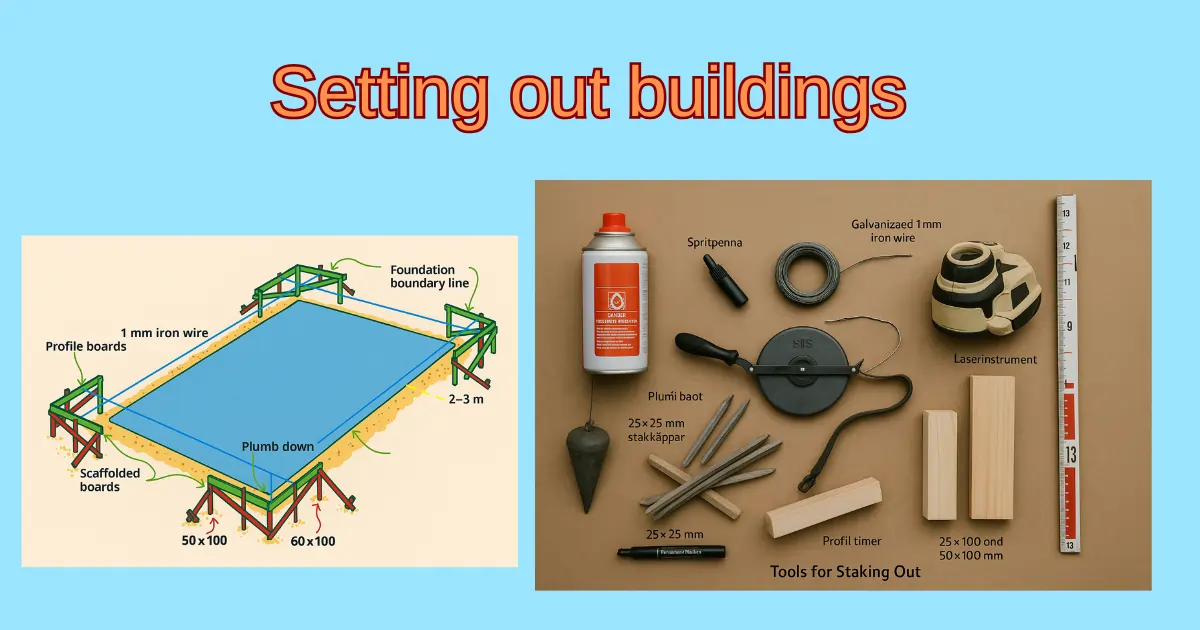Setting out is the first step in laying out design layouts onto a site plot. Setting out involves the locating of the house’s positions in plan and level; how they are executed differs depending on the site conditions and type of project.
Setting out is done either by the owner or the municipality of the city. However, the most important thing is that municipalities always check and approve the site setting out.
The foundation must be placed in the correct location, at the proper level, and according to the house’s layout. Setting out is often executed by the owner, but the municipality performs checking and monitoring to make sure it is fulfilling standards and local laws. This is necessary to avoid mistakes and poor quality. All work is inspected and approved by the municipality before further work can proceed.
Let us explore all work done before the foundation construction works themselves can begin.
The aim is to mark the location of the house before the work begins. What is to be built must be correctly marked. In addition to the location of the house, it may be important to also mark, for example, property boundaries, foundations for existing outbuildings, etc., as the figure shows.
It is easier to position a new building if one already has reference points, such as the location of an existing building or other known points in the terrain. However, with a new building, one has only the site plot to begin with, which forms the outside boundaries of the owner’s land plot and a fixed point as a benchmark for reference.
In steeply sloping terrain, the staking can become significantly more difficult, and vegetation can become a hindrance, so it is needed to clear the site before work begins.
Setting out can be formed in two stages. The first is rough staking and follows the detailed staking by the builder.
Rough staking is the initial step in construction layout, where surveyors mark the approximate location and orientation of a building or structure on-site. It guides excavation and grading work, using tools like wooden stakes, tape measures, string lines, and GPS. While not highly precise, it ensures the project begins in the correct area before detailed staking takes place.
Detailed staking is a precise surveying process used to mark the exact location, dimensions, and elevations of a building’s key structural elements on-site. It guides construction teams during foundation and structural work. Using high-accuracy tools like total stations, prisms, and RTK GPS, surveyors set out corners, walls, and height levels based on construction drawings. This ensures the building is constructed exactly as planned.
Often, it is the municipality that does the initial rough staking. The municipality then locates the corners of the house with pegs, and a benchmark elevation is marked on a tree, mountain top, or any fixed object to serve as a reference for the building elevation levels. If the owner does the setting out, the municipality will control and approve it before the work begins.
The process of setting out buildings
After the rough staking out, the detailed setting out proceeds, where timber profiles and batter boards are erected at convenient distances and positions from the exterior house walls.
As shown in the figures above, 2-3m from the corners of the exterior boundaries of the house, timber profile stakes are erected. The profiles should be positioned so they don’t get in the way of construction machines; excavators and other heavy equipment must be able to work without colliding with the profiles.
If necessary, the excavation can commence after rough staking, and then the profiles can be erected so that they are not damaged.
The timber profiles must be sturdy enough not to be damaged. The batter boards are set in the ground and nailed or otherwise fixed in place. When building on rock, they are nailed directly into the rock using plugs.
When the excavation work with heavy equipment is completed, the profiles may need to be adjusted and re-nailed due to settlement or damage. It is important to make the profiles sufficiently stable so they won’t be disturbed by wind or construction work.
The profiles consist of boards fixed between two stakes. It is important that the profiles are straight (in a row) and, if possible, at the same height. They are placed 2-3m from the exterior house boundary, placed opposite each other on each side of the building.
First, all profiles with one long side are placed, and then, using a string stretched over the base corners, the corresponding profiles on the opposite side are placed.
Before attaching the vertical stakes of the profiles in place, they should be checked with a spirit level to ensure they are truly vertical. Because the heights of the horizontal boards will be set on the vertical stakes before fixing them. Until the boards are fixed at the final levels, the vertical stakes can be temporarily fixed together with provisional diagonal braces.
If the timber profiles can not be placed at the same height, for example, due to sloping terrain, they can be placed with 1,2 or 3 height differences from each other.
On the profiles, then the control lines will be set. The house’s wall control lines from the rough staking can be used to elongate them and lay the strings between opposite profile stakes.
For setting out then a string is laid tightly between opposing timber profiles, and the string level on the timber profile board is marked with 2 nails of 60 mm size. Then the timber profiles can be painted to indicate they are ready for commencing work. The levels can also be written as +25.63 or as 1m over the ground or exterior wall line. If other profiles are needed than the corners, they can be added anywhere and can be erected as needed.

After the strings that mark the houses or foundations exterior lines are put in place, each rectangle must be checked for being right-angled by measuring the diagonals, which must have accuracy in a few cm.
Since the rough staking is not sufficiently exact and the municipality will want to check it, this is the right time to make them do it when the profile stakes are ready now.
It is necessary to prevent strings from coming in the way of the ongoing construction works, such as formwork setting, plastering, and other works. Therefore, it may be better not to mark the house’s actual exterior sides. Alternatively, distances of about 100mm are measured as offset from them, and during formwork works, an equal distance of 100mm can be measured from the string lines.
When the work is ongoing, at some time it can become impractical to lay the strings over the site area, so it can become necessary to remove them sometimes and place them again for measurements and control.
How to measure excavation work quickly
Some auxiliary stakes and profiles in T form can be used to quickly mark the construction limits.
Two small stakes that are nailed to the ground and continue over the length from the control lines can serve as somewhat rough marking out for the foundations’ exterior sides, or before excavation works, as a boundary of the excavation. A person can see through the posts until they line up, and the eye line will be the same as the control line extension.
Even the T-form wood profile can be used to set the height roughly. A person will hold the T profile between two profiles at the ends. Another person stands beside one profile and sees through in the direction of the T profile, aligning the line of sight parallel to the string lines. When the top of the T profile aligns with the line of sight, the right height is reached. This way, the excavation level can be roughly measured.
What detailed setting out involves
For detailed setting out, the height and the side limits must be measured with survey instruments and plumbs after laying the control strings again. The plumbs also must be used to get the exact points down on the ground. Survey equipment such as laser instruments is commonly used for this.
There will be removal of the control string and the survey instruments now and then, so it is necessary to quickly find the original control lines again and again. The profile string level is marked on the profile’s horizontal timber member. It is also good to have another reference level fixed point on a tree or a house nearby that has the level written, preferably in absolute height over sea level, or an iconic place like a golf field.
During the construction setting out is first done for excavation and under foundation filling, and then for setting the formwork of the foundation slab, slab on grade, or foundation piers. And after that, to the foundation wall.

